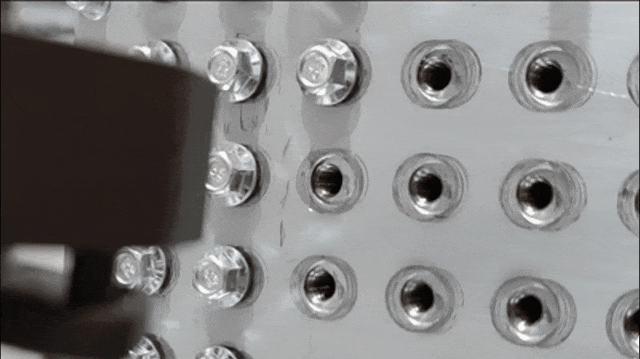Floating Tightening Technology: Saying Goodbye to Hole Position Deviations and Moving Towards Efficient Assembly
Especially in welding workshops, the degree of automation is gradually approaching 100%. However, due to the large size and numerous curves of vehicle body components, deviations in fixture positioning or dimensional manufacturing accuracy of the product housing can lead to poor consistency in bolt hole positions. Additionally, some components may shift in position after welding, further exacerbating the deviation issues of through-holes and threaded holes. This results in a high rate of tightening failures, thereby affecting the production line's cycle time.
Traditional Solutions
2D Camera Positioning and Recognition: Commonly used in the market, this method has spatial recognition angle deviations. Camera imaging not only affects the production cycle and space layout but also has a longer debugging cycle and higher hardware costs.
Floating Mechanism for Sleeve and Tightening Tool: This approach complicates the overall structure, increases costs, and adds to the robot's load requirements.
Floating Tightening Technology
Floating tightening technology, through a specially designed sleeve structure, allows the sleeve to have a certain degree of float within a range. The floating distance can self-adaptively adjust according to changes in the avoidance length. Compared to traditional solutions, sleeve floating technology is simpler and more efficient.
Advantages of Floating Tightening Technology
1. Deviation Compensation and Smooth Hole Entry
During the process of inserting and tightening screws into through-holes, the sleeve can float within a certain radial range to compensate for positioning deviations. Typically, the allowed deviation range is within 0.5-2.5 mm. This addresses issues such as difficulty in hole entry and inaccurate tightening data caused by misalignment between bolt holes and the sleeve, thereby increasing the success rate of bolt tightening.

2. Equipment Savings and Efficiency Improvement
The floating solution optimizes the structure of the sleeve device itself. There is no need for industrial cameras or floating mechanisms. This not only reduces the initial equipment debugging work but also avoids time-consuming and unclear fault diagnosis during the assembly process. It enhances the speed and accuracy of automated assembly. Additionally, it allows for a certain tolerance in component material dimensions, reducing the precision requirements for parts and thereby lowering manufacturing costs.
Diverse Application Scenarios
Floating tightening technology, which effectively solves hole positioning deviation issues, has a wide range of applications in the field of bolt assembly. It is suitable for assembly scenarios such as white body, battery packs, motors, and engine housings in new energy vehicles. It further improves the quality and efficiency of bolt tightening, providing strong technical support for industry development.
.png)
.png)
.png)
.png)





.png)
.png)
.png)
.png)




